雀巢公司介绍英文PPT
- 格式:ppt
- 大小:1.67 MB
- 文档页数:1
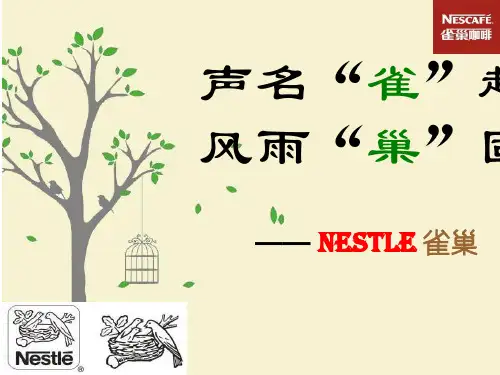
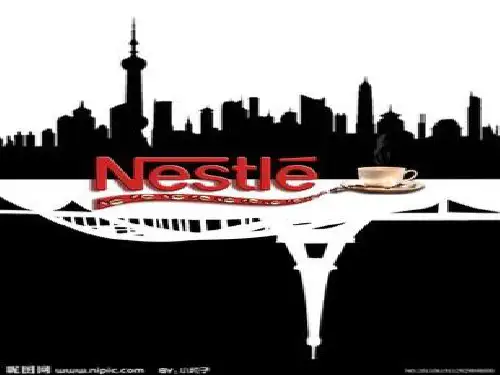


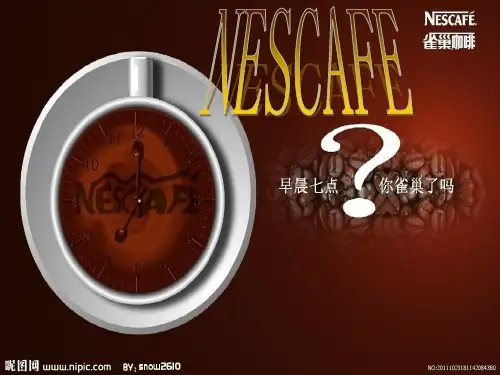
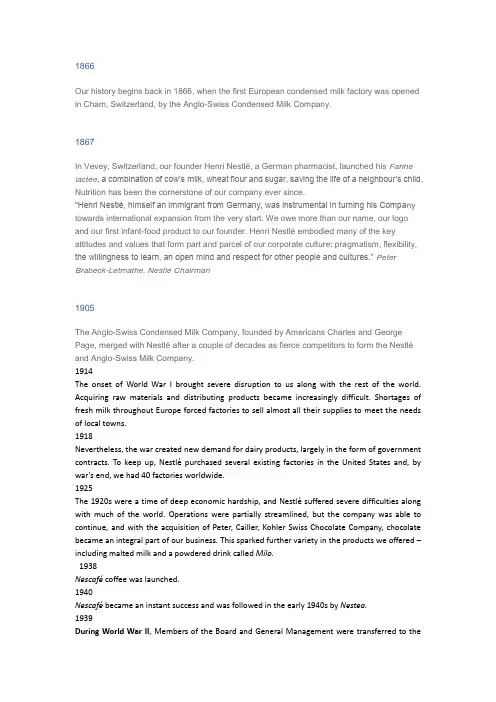
1866Our history begins back in 1866, when the first European condensed milk factory was opened in Cham, Switzerland, by the Anglo-Swiss Condensed Milk Company.1867In Vevey, Switzerland, our founder Henri Nestlé, a German pharmacist, launchedhis Farinelactée, a combination of cow’s milk, wheat flour and sugar, saving the life of a neighbour’s child. Nutrition has been the cornerstone of our company ever since.“Henri Nestlé, himself an immigrant from Germany, was instrumental in turning his Compan y towards international expansion from the very start. We owe more than our name, our logo and our first infant-food product to our founder. Henri Nestlé embodied many of the key attitudes and values that form part and parcel of our corporate culture: pragmatism, flexibility, the willingness to learn, an open mind and respect for other people and cultures.”Peter Brabeck-Letmathe, Nestlé Chairman1905The Anglo-Swiss Condensed Milk Company, founded by Americans Charles and George Page, merged with Nestlé after a couple of decades as fierce competitors to form the Nestléand Anglo-Swiss Milk Company.1914The onset of World War I brought severe disruption to us along with the rest of the world. Acquiring raw materials and distributing products became increasingly difficult. Shortages of fresh milk throughout Europe forced factories to sell almost all their supplies to meet the needs of local towns.1918Nevertheless, the war created new demand for dairy products, largely in the form of government contracts. To keep up, Nestlé purchased several existing factories in the United States and, by war's end, we had 40 factories worldwide.1925The 1920s were a time of deep economic hardship, and Nestlé suffered severe difficulties along with much of the world. Operations were partially streamlined, but the company was able to continue, and with the acquisition of Peter, Cailler, Kohler Swiss Chocolate Company, chocolate became an integral part of our business. This sparked further variety in the products we offered –including malted milk and a powdered drink called Milo.1938Nescafé coffee was launched.1940Nescafé became an instant success and was followed in the early 1940s by Nestea.1939During World War II, Members of the Board and General Management were transferred to theU.S. where they coordinated Nestlé activities in the Western Hemisphere, the British Empire and overseas.1943Ironically, having slowed the initial launch of Nescafé, the war then helped to popularise it; with the United States entering the war, Nescafé coffee became a staple beverage of American servicemen serving in Europe and Asia.1945The close of World War II marked the beginning of a particularly dynamic phase of our history. Dozens of new products were added as our growth accelerated and we acquired outside companies.1947The Maggi products, from seasoning to soups, become part of the Nestlé family following the merger with Alimentana S.A.1948Nesquik, the instant chocolate drink, was developed in the United States. Its original name of Quik was a direct allusion to the speed and simplicity of its preparation.1974For the first time we diversified outside the food industry when we became a major shareholder in L'Oréal, one of the world's leading makers of cosmetics.1981In 1981 the World Health Assembly adopted the International Code for the Marketing of Breast-milk Substitutes (“WHO Code”) and recommended that its Member States implement it. Nestlé was the first company to develop policies based on the WHO Code and apply them across our entire operations in developing countries.1984An improved bottom line allowed us to make new acquisitions, including a public offer of USD 3 billion for the American food giant, Carnation. At the time, this was one of the largest acquisitions in the history of the food industry.1986The Nespresso story began in 1986 with a simple idea: enable anyone to create the perfect cup of espresso coffee, just like a skilled barista.1988The Italian brand Buitoni, in Sansepolcro, became part of our portfolio in 1988. Nestled in the hills of Tuscany, Casa Buitoni is the symbol of the brand’s ongoing commit ment to quality, creativity, and tradition.The UK-based organisation, Baby Milk Action, launched a boycott against Nestlé. While there are still boycott activities in the UK today, the following organisations have officially ended their support for it: the General Synod of the Church of England in July 1994, the Royal College of Midwives in July 1997, the Methodist Ethical Investment Committee in November 2005 and the United Reformed Churches in November 2011.1993The first half of the 1990s were favourable for Nestlé with the opening up of Central and EasternEurope, as well as China – good news for a company with such far-flung and diverse interests. 2001We merged with the Ralston Purina Company, which had been founded in 1983, in 2001 to form a new pet food company, Nestlé Purina PetCare Company.2002Two major acquisitions were made in North America in 2002: in July, the merger of our U.S. ice cream business with Dreyer’s; and in August, a USD 2.6 billion acquisition of Chef America Inc., a leading frozen food product business.2003Nestlé acquired Mövenpick Ice Cream, enhancing our position as a market leader in the super premium category.2007We acquired Novartis Medical Nutrition, Gerber and Henniez.2009We held the first Creating Shared Value Forum in New York, with leading experts in the areas of nutrition, water and rural development coming together to discuss serious global challenges facing us in these three areas and the role of business in helping to solve them. The Creating Shared Value Forum has been held on an annual basis since then, with London in 2010 and Washington, D.C. in 2011.We celebrated the opening of the Chocolate Centre of Excellence in Broc, Switzerland.January 2010We sold our remaining Alcon shares to Novartis and also acquired Kraft Foods’ frozen pizza business.March 2010We faced a challenge from Greenpeace who wanted to be reassured about our commitment to sustainable Palm Oil. It was the first time we saw social media being used in a substantial way to challenge us and ask questions. We didn’t get the handling of our response to the campaign itself quite right in social media, but on the issue at its heart –palm oil - we took steps to both strengthen our position and to explain it more clearly.。
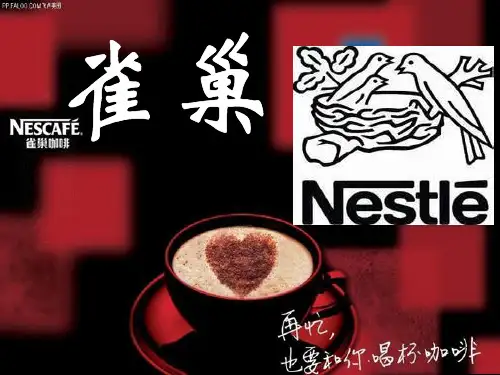

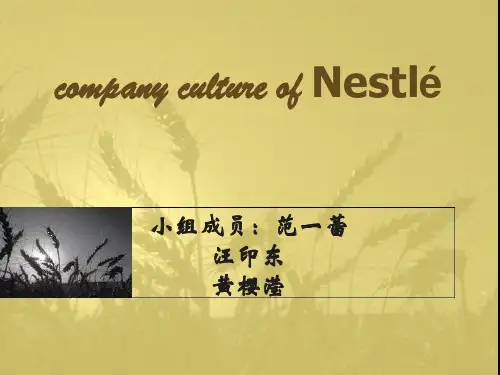
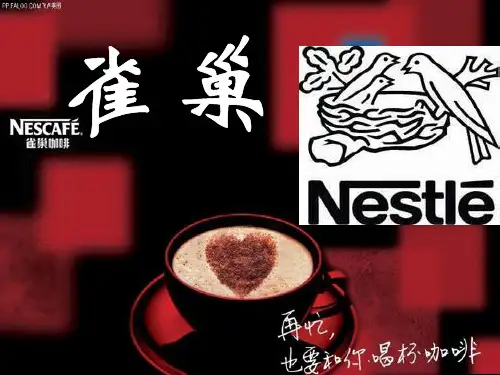
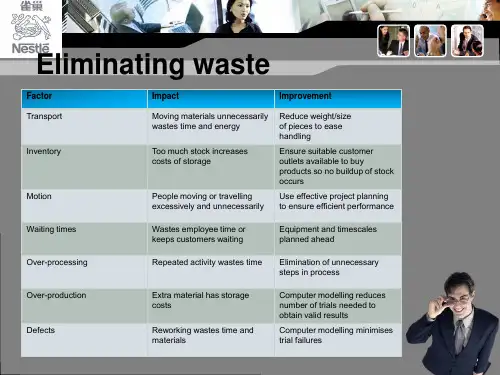
精品好资料——————学习推荐雀巢公司英文简介1. company profileNestel (Nestle) using his own name for the brand name, but its name in the English language is "comfortably settled down" and "side" means. Now, Nestlé coffee has become China's markets and the world's leading brand of instant coffee.the product such as Nescafe 1 +2、Nestle Espresso Coffee 1 +2、Nescafe Ice 1 +2、Nestle coffee, alcohol 100% pure coffee products、Nestle Coffee-Mate、Nestle Gold Coffee and so on. Product performance: the selection of the finest quality coffee beans mainly raw materials, through the fine fire baking, add coffee mate and sugar well drinks from the deployment. Mellow flavor, smooth texture, easy to drink, a red can. For the peer market leading position in their living brand, is a typical high-grade coffee, the price is higher. Brand awareness: For many consumers, Nestle is instant coffee. In the instant coffee market, Nestle is undoubtedly the leading brands and occupied most of the market.The core brand: Nestle coffee (Nescafe) the name of the language in the world, are giving a feeling of uncertainty, strengthen the Nestle coffee can you nervous, tired after the injection of energy, make you feel relaxed moment.2. Nescafe business history1866-1905In the 1860s Henri Nestlé, a pharmacist, developed a food for babies who were unable to breastfeed. His first success was a premature infant who could not tolerate his mother's milk or any of the usual substitutes. People quickly recognized the value of the new product, after Nestlé's new formula saved the child's life, and soon, Farine Lactée Henri Nestléwas being sold in much of Europe. 1905-1918 In 1905 Nestlé merged with the Anglo-Swiss Condensed Milk Company. By the early 1900s, the company was operating factories in the United States, Britain, Germany and Spain. World War I created new demand for dairy products in the form of government contracts. By the end of the war, Nestlé's production had more than doubled.1918-1938 After the war Government contracts dried up and consumers switched back to fresh milk. However, Nestlé's management responded quickly, streamlining operations and reducing debt. The 1920s saw Nestlé's first expansion into new products, with chocolate the Company's second most important activity 1938-1944 Nestléfelt the effects of World War II immediately. Profits dropped from $20 million in 1938 to $6 million in 1939. Factories were established in developing countries, particularly Latin America. Ironically, the war helped with the introduction of the Company's newest product, Nescafé, which was a staple drink of the US military. Nestlé's production and sales rose in the wartime economy. 1944-1975 The end of World War II was the beginning of a dynamic phase for Nestlé. Growth accelerated and companies were acquired. In 1947 came the merger with Maggi seasonings and soups. Crosse & Blackwell followed in 1960, as did Findus (1963), Libby's (1971) and Stouffer's (1973). Diversification came with a shareholding in L'Oréal in 1974.1975-1981 Nestlé's growth in the developing world partially offset a slowdown in the Company's traditional markets. Nestlé made its second venture outside the food industry by acquiring Alcon Laboratories Inc..1981-1995 Nestlé divested a number of businesses1980 / 1984. In 1984, Nestlé's improved bottom line allowed the Company to launch a new round ofacquisitions, the most important being American food giant Carnation.1996-2002 The first half of the 1990s proved to be favorable for Nestlé: trade barriers crumbled and world markets developed into more or less integrated trading areas. Since 1996 there have been acquisitions including San Pellegrino (1997), Spillers Petfoods (1998) and Ralston Purina (2002). There were two major acquisitions in North America, both in 2002: in July, Nestlé merged its U.S. ice cream business into Dreyer's, and in August, a USD 2.6bn acquisition was announced of Chef America, Inc.2003 + The year 2003 started well with the acquisition of Mövenpick Ice Cream, enhancing Nestlé's position as one of the world market leaders in this product category. In 2006, Jenny Craig and Uncle T oby's were added to the Nestléportfolio and 2007 saw Novartis Medical Nutrition, Gerber and Henniez join the Company.3. corporate structureFor a long time, companies are set by function departments, according to the management of classified management, formed a pyramid management organizational structure. This kind of organization structure has been more and more not adapt to the requirement of information society. Module combination marketing from the business department and business department is divided into a number of smaller business department and the headquarters unified management, as a result, the management organization structure is getting the "flat" become "thin", integrated management status and role is more prominent, the network organization structure form. The hierarchical organization is the basic unit of the traditional at a certain level, the command chain and network organization system is the basic unit of independent business units. The nestle module combination marketing, make network organization structure, also make the nestle has the characteristics of the network: one is to use special means of market instead of administrative means to contact between the various business units and the relationship between the corporate headquarters. Network system structure of market relationship is a kind of based on the capital on the transfer of property rights, mobility and relatively stable commodity business relationship, a full range of market relations. Second, on the basis of network organization structure has formed powerful virtual functions. Each individual in the network system structure of business entity can be a variety of ways to borrow external resources, external resources to combination, creating huge competitive advantage.4.Core product1, dairyand nutrition. Nestle has one hundred and forty dairy production experience for many years, all over the world more than ninety dairy factory has the world first-class production line. Nestle dairy and nutrition according to consumption group is divided into several different species: for the products of the pregnant women, for children is being placed in growth stage, for teenagers, adults and older.2,health and nutrition products. Nestle healthcare nutrition people need nutritional supplements provide a series of comprehensive and balanced nutrition products. Can be used for patients undergoing treatment or due to a lack of nutrients in diet or for other reasons need compensatory nutrition.3 the drinking water. Nestle water industry group is a leading global bottled water experts, products all over the world more than 130 countries, with 72's of people around the world love bottled water brands.。